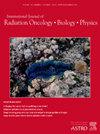Signal-Seeking P2R Trial of Proton or IMRT Dose Intensification in GBM: NRG-BN001
IF 6.5
1区 医学
Q1 ONCOLOGY
International Journal of Radiation Oncology Biology Physics
Pub Date : 2025-10-14
DOI:10.1016/j.ijrobp.2025.08.068
引用次数: 0
Abstract
Purpose/Objective(s)
RT dose-intensification in GBM demonstrates survival (OS) improvement, up to 60 Gy; escalation >60 Gy in the pre-temozolomide (TMZ) era failed to lengthen OS. Non-randomized concomitant RT TMZ trials have established simultaneous integrated boost (SIB) intensification to 75 Gy as safe and potentially more effective. Further, lymphopenia in GBM is strongly associated with reduced OS; significant associations between lymphopenia and volume of brain irradiated are established; level 1 evidence demonstrates less lymphopenia with protons. In this signal-seeking Phase 2 randomized trial we tested the dual hypothesis of SIB intensification (DI) to 75 Gy with photon therapy (previously presented), and with proton therapy with the expectation of benefit from less lymphopenia. Here we present the proton cohort results.
Materials/Methods
Patients with newly diagnosed GBM, KPS≥70, with ≤5cm residual tumor/cavity, after central pathology confirmation and central MGMT analysis were stratified by RPA class and MGMT status and randomized 1:2 at pre-declared photon centers to 60 Gy/30 fxs with photons or 75 Gy/30 fxs with proton therapy (DI), providing separate and independent SOC controls for photon and proton cohorts. Standard concomitant and adjuvant TMZ usage was included. For the 193-patient proton cohort, there was 80% power to detect a hazard ratio (HR) = 0.72 (median OS D 16.0 to 22.2 months), with a one-sided α at 0.15, 1 interim futility analysis.
Results
Between October 2014 and May 2022, the proton cohort randomized 193 patients. Patients were balanced between arms for pretreatment characteristics (the proton DI arm had numerically more unmethylated GBMs, more patients with lower KPS, and fewer with gross-totally resected tumors versus the 60 Gy comparator). No statistically significant between arms differences in high grade toxicities (all) were observed; specifically, ≥G3 lymphopenia and ≥G4 neurologic toxicity rates for SOC vs. proton DI were 23.4 vs 17.1, and 1.8% vs 5%. The proton 75 Gy arm demonstrated improved OS (HR= 0.81, 70% CI 0.67-0.98, p =0.11) and remained significant when correcting for MGMT methylation status and RPA class. The absolute survival improvement in favor of 75 Gy proton arm at 2 and 3 years was 6.8% (43.1 vs 49.9%) and 4.6% (25.4 vs 30%), with median OS of 22.8 (20-28.6) vs 22 (15.8-27.8) months. As expected, OS was superior for both MGMT methylated as well as for lower RPA class patients, and without significant interaction between treatment arm and either MGMT status or RPA. Results didn’t meet criteria for comparing 75 Gy protons vs 75 Gy photons.
Conclusion
This signal-seeking P2R multicenter NRG Oncology trial did not demonstrate OS improvement with 75 Gy photon SIB (previously reported) but met the pre-specified statistical hypothesis for improved OS for the proton 75 Gy cohort, providing the necessary data to design and conduct a definitive P3 randomized trial.
质子或IMRT剂量增强治疗GBM的信号寻求P2R试验:NRG-BN001
目的/目标:放疗剂量增强在GBM中显示生存(OS)改善,可达60 Gy;在替莫唑胺前(TMZ)时代,60 Gy的升高未能延长OS。非随机联合RT TMZ试验已经证实,同时综合增强(SIB)至75 Gy是安全的,可能更有效。此外,GBM中淋巴细胞减少与OS降低密切相关;淋巴细胞减少与脑辐照体积之间存在显著关联;一级证据显示较少的质子淋巴细胞减少。在这个寻找信号的2期随机试验中,我们测试了双重假设,即光子治疗将SIB强化(DI)至75 Gy,以及质子治疗,期望从更少的淋巴细胞减少中获益。在这里,我们给出质子队列的结果。材料/方法新诊断的GBM患者,KPS≥70,肿瘤/腔残余≤5cm,经中央病理确认和中央MGMT分析后,根据RPA等级和MGMT状态进行分层,并在预先声明的光子中心随机分为60 Gy/30 fxs和75 Gy/30 fxs质子治疗(DI),为光子和质子队列提供单独独立的SOC对照。包括标准的伴随和辅助TMZ的使用。对于193例质子队列,有80%的能力检测到危险比(HR) = 0.72(中位OS D 16.0至22.2个月),中期无效分析的单侧α为0.15,1。结果在2014年10月至2022年5月期间,质子队列随机分配了193例患者。患者的预处理特征在两组之间进行平衡(质子DI组的未甲基化GBMs数量更多,KPS较低的患者更多,与60 Gy比较组相比,总切除肿瘤的患者更少)。高级别毒性(全部)各组间无统计学差异;其中,≥G3淋巴细胞减少症和≥G4神经毒性率分别为23.4 vs 17.1, 1.8% vs 5%。质子75 Gy臂显示出改善的OS (HR= 0.81, 70% CI 0.67-0.98, p =0.11),并且在纠正MGMT甲基化状态和RPA类别时仍然显著。75 Gy质子组在2年和3年的绝对生存改善分别为6.8% (43.1 vs 49.9%)和4.6% (25.4 vs 30%),中位OS为22.8 (20-28.6)vs 22(15.8-27.8)个月。正如预期的那样,对于MGMT甲基化和较低RPA级别的患者,OS都优于治疗组,并且治疗组与MGMT状态或RPA之间没有显着的相互作用。结果不符合比较75 Gy质子和75 Gy光子的标准。结论:该信号寻求P2R多中心NRG肿瘤学试验并未显示75 Gy光子SIB改善OS(先前报道),但满足了75 Gy质子队列改善OS的预先指定的统计假设,为设计和实施明确的P3随机试验提供了必要的数据。
本文章由计算机程序翻译,如有差异,请以英文原文为准。
求助全文
约1分钟内获得全文
求助全文
来源期刊
CiteScore
11.00
自引率
7.10%
发文量
2538
审稿时长
6.6 weeks
期刊介绍:
International Journal of Radiation Oncology • Biology • Physics (IJROBP), known in the field as the Red Journal, publishes original laboratory and clinical investigations related to radiation oncology, radiation biology, medical physics, and both education and health policy as it relates to the field.
This journal has a particular interest in original contributions of the following types: prospective clinical trials, outcomes research, and large database interrogation. In addition, it seeks reports of high-impact innovations in single or combined modality treatment, tumor sensitization, normal tissue protection (including both precision avoidance and pharmacologic means), brachytherapy, particle irradiation, and cancer imaging. Technical advances related to dosimetry and conformal radiation treatment planning are of interest, as are basic science studies investigating tumor physiology and the molecular biology underlying cancer and normal tissue radiation response.

 求助内容:
求助内容: 应助结果提醒方式:
应助结果提醒方式:


